Spotlight on Alex Boerner
Feb 15, 2012
Originally published 02/19/2012
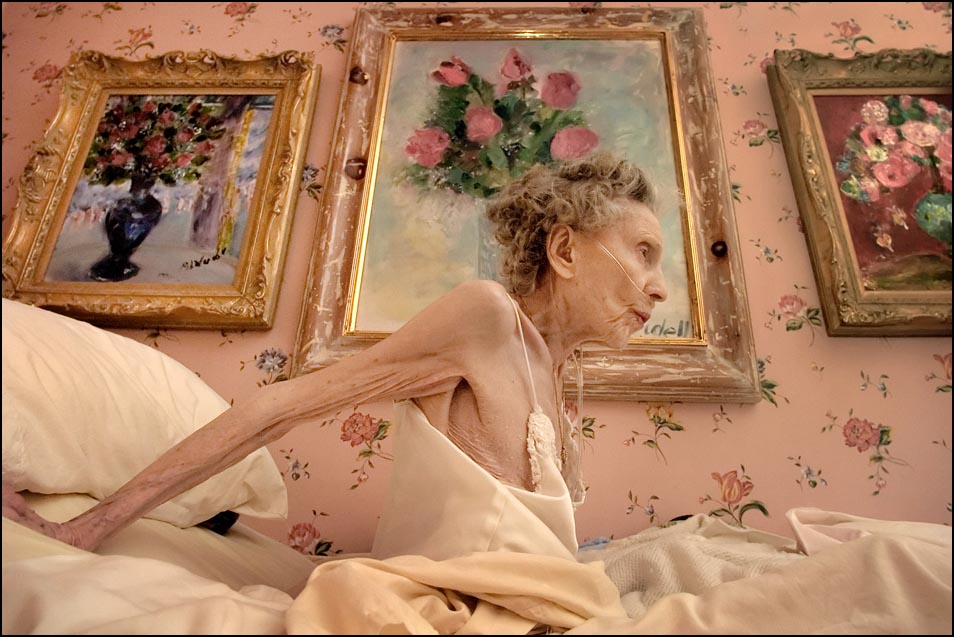
ALEX:
Thank you for inviting me to be a part of The Image, Deconstructed. This is a very thoughtful and valuable resource and I'm honored to be asked to discuss this photograph. The woman, Marian Wardell-Qualey, was 101 when this picture was taken. The photograph was a result of a daily assignment to cover an organization called the Visiting Nurses Association of Florida. They are a non-profit group that make home visits to people who require periodic nursing care. Marian had a friend who was her in-home caregiver, but the VNA still came to check on her regularly to record her vital signs and check on her overall health.
TID:
It seems like a pretty straightforward daily assignment, yet you were able to get such a powerful, lasting, image for the shoot. We'd like to deconstruct what was going on in your mind when you first arrived up to the moments before you made the picture.
ALEX:
I try not to pre-visualize, but going into this assignment I had an idea of what to expect. It was a story about the anniversary of the VNA and I knew that I was going into a situation where a nurse was going to be working with a patient. The unknowns were the setting, the condition of the patient and what type of relationship they had. At the very least, I was confident that I would have a picture of them going through their routine, but was hoping to see a moment between the nurse and Marian that would reveal the type of connection they might have.
In attendance was a reporter, the nurse and a VNA public relations person. Marian lived in a house within a gated community. When we arrived, we met her caregiver who told us about her history. She spent much of her life in the Detroit area and was part of a wealthy family. She was an artist and had been an art teacher earlier in her life. She mostly painted with oils. Unfortunately, she had developed macular degeneration, a disease associated with aging that gradually destroys sharp, central vision, and she could no longer paint.
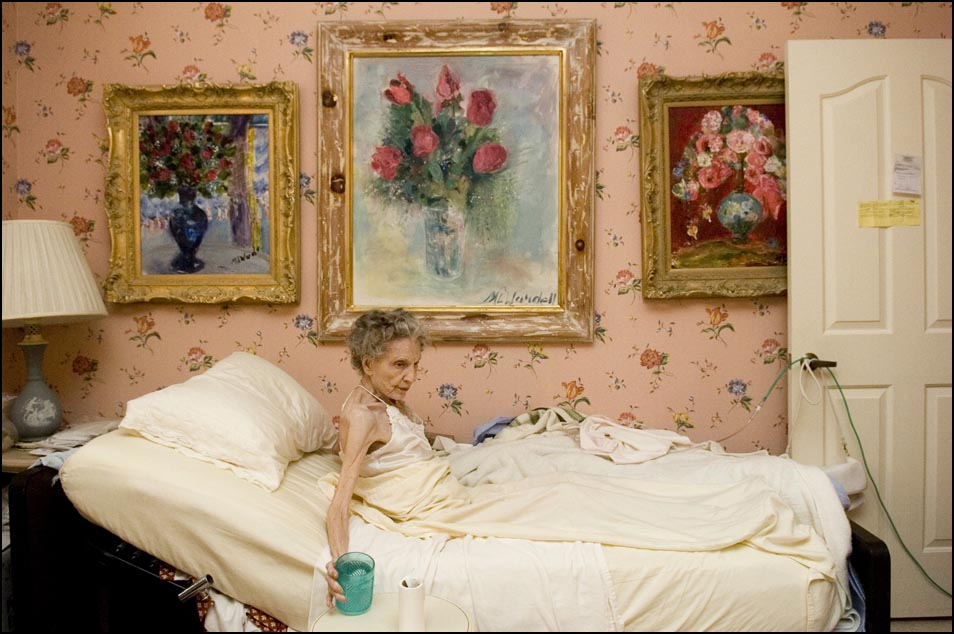
As we approached her room, I noticed that a DNR (do not resuscitate) order was hanging on her door. When we entered, the room was moderately lit with floor lamps and a dim ceiling lamp. The walls were covered in pink wallpaper with pink flowers and there was a small collection of her artwork hanging all around the room.
Marian was laying in a hospital bed that had been brought into the room. We all took a minute to introduce ourselves to her and I remember her being very excited, gracious and thankful for both the VNA and for the newspaper to being there. She had strong energy for being 101 years-old. Despite her poor eyesight (or maybe because of it), she was attuned to everything that was happening and was very engaging with everyone in the room. It made for a much more relaxed atmosphere.
When I come to a scene, the first thing I do is to try to make sense of the setting and find clean angles that hopefully include storytelling elements, then wait for something to happen.
In this situation, I knew I needed a photo that would tell the story of the VNA. I wasn't sure how much time I'd have, so before looking at different ways to photograph the situation, I got in close and spent a little time right in front of Marian and the nurse. With a wide-angle lens, I was able to show their interaction and gather some of the atmosphere as well. At that point, I had a safe picture that would work to tell the story. The nurse was wonderful and very professional, but the angles from which she was working weren't lending themselves to providing an expression of any kind of connection between she and Marian.
Once I realized that that wasn't likely to change, I moved onto looking at other ways to photograph them. I stepped back and began shooting from further away. There was a mirror on one side of the room in which I could get them reflected by the bed and include some foreground elements, like a crucifix, that were indicative of Marian's character.
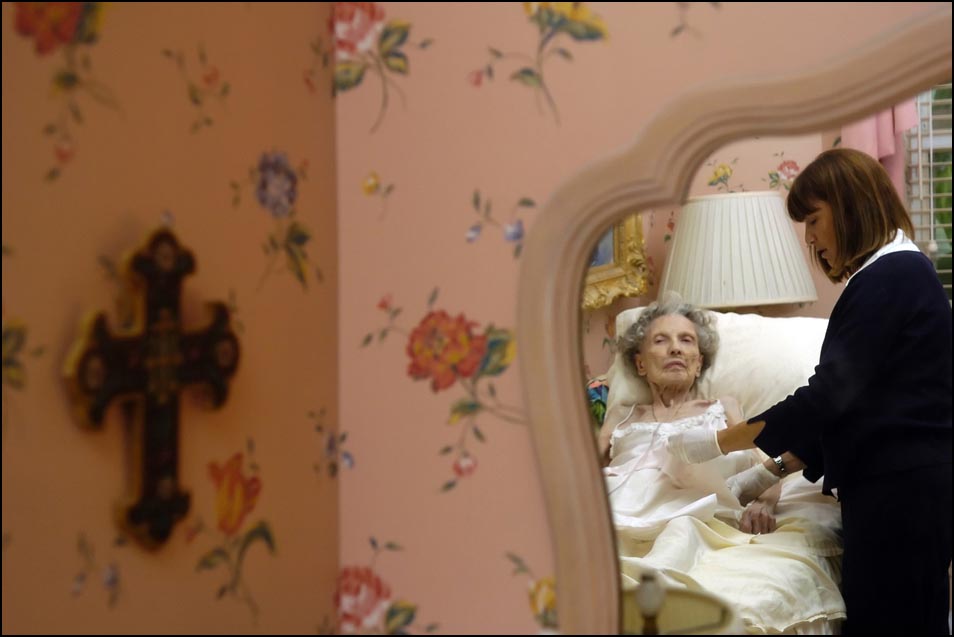
As the nurse was finishing her appointment, I moved back in closer to the bed. I began to photograph Marian from a low angle with a 14mm lens. At that point, the nurse put on her coat and I can't remember if Marian sat up on her own or if the nurse asked her to sit up, but Marian was upright in the bed and the nurse had left the side of the bed to go talk to the reporter.
This gave me the first opportunity to photograph Marian by herself, which was nice. Sometimes it's great to cover a story with a reporter because you get a chance to just look around while they are engaged with the subject. Initially, I knew I wanted to try and photograph Marian in her room, by herself. It was her home, filled with her life and her art. She looked very frail, but her spirit was strong. For 101 years old, she was so ALIVE. That's what I hoped to capture.
TID:
Now, onto the moment of the image. What was going on in your mind and why did you make the choices you made to put yourself in the position to make the image?
ALEX:
Because of the lightness of the situation - which had everything to do with Marian's spirit - I felt very comfortable photographing her from a very intimate position. The low, wide-angle photos of Marian's fingers I had taken a little earlier showed me that I could get in close and still fit almost all three of her paintings on the wall next to her bed into the frame.
Earlier, I had taken a few pictures from a little further back, with a slightly longer focal length and on a more even level. They were okay, but Marian had so much detail in her face and skin that I felt I wanted to be close to her so it would be more evident. The super wide-angle lens allowed me to do this and still keep the context of the paintings.
A side note: We were using Nikon D2h cameras and shot JPEGS, but when Marian sat forward I switched the camera to shoot in the RAW format. When she was sitting up, with her paintings behind her in this warm setting, I thought that if a decent portrait of Marian presented itself that I wanted to have the camera working to the best of its capability.
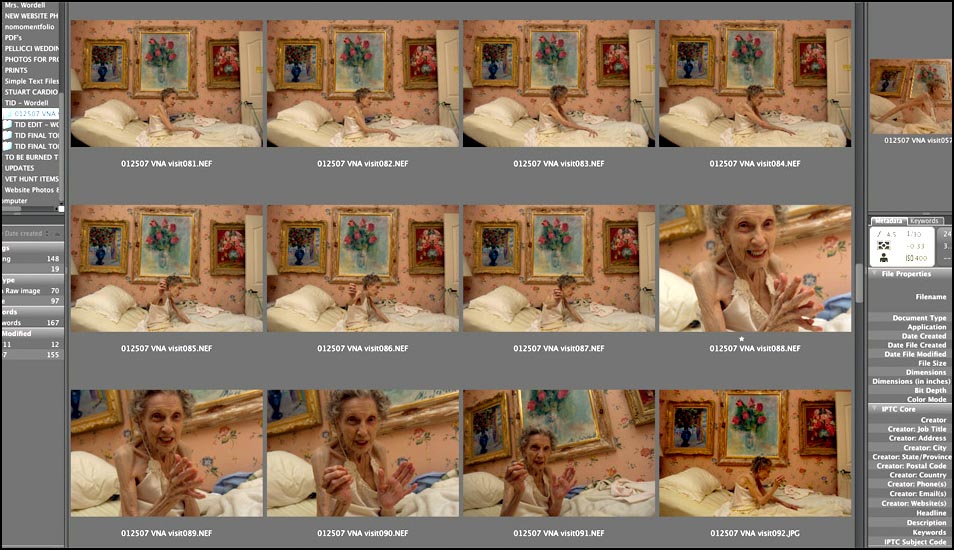
I also turned on the flash and bounced it off the wall outside the frame to the right. This did add a little dimension to her face, but overall I don't think it was a good idea because it created some uneven lighting that I ended up burning down. The nurse then had Marian sit up in order to check something. As she sat forward she propped herself up with her arms and just looked straight ahead. I took two photos right then. They were taken about one minute after she sat up in her bed. She was sitting up - leaning forward and engaged - with her eyes were wide open.
Shortly after that, she began looking around and talking. When that happened, I moved around to the right a bit while still close up. The pictures from that perspective didn't have the same feeling. The nurse had come back again and began to interact with her, so I backed up and photographed her from a little further away. After the nurse had finished, Marian stayed sitting upright on her own for about 10 minutes, bracing herself with her arms occasionally.
TID:
Was there any complication in making an image in such a delicate situation? If so, how did you handle it?
ALEX:
There wasn't much complication in this situation, but I think that was because there was a lot of communication beforehand that everyone was comfortable. This assignment, in particular, was pretty straightforward. For both the nurse and for Marian, it was pretty much business as usual. Our presence didn't really change that dynamic.
In delicate situations, I think communication with the subjects is key. Discussing the reasons why you want to photograph someone is a good place to start. It lets people understand why they are important, what your ideas are and if possible, what the outcome might be in regards to publication (a lot of people ask me what I plan to do with the photos). If they are on board, then they become invested in the process and you have made a connection with them through that understanding. From there, the connection can deepen as you move forward. And if that foundation gets established, you will be more likely to work openly and discuss important developments.
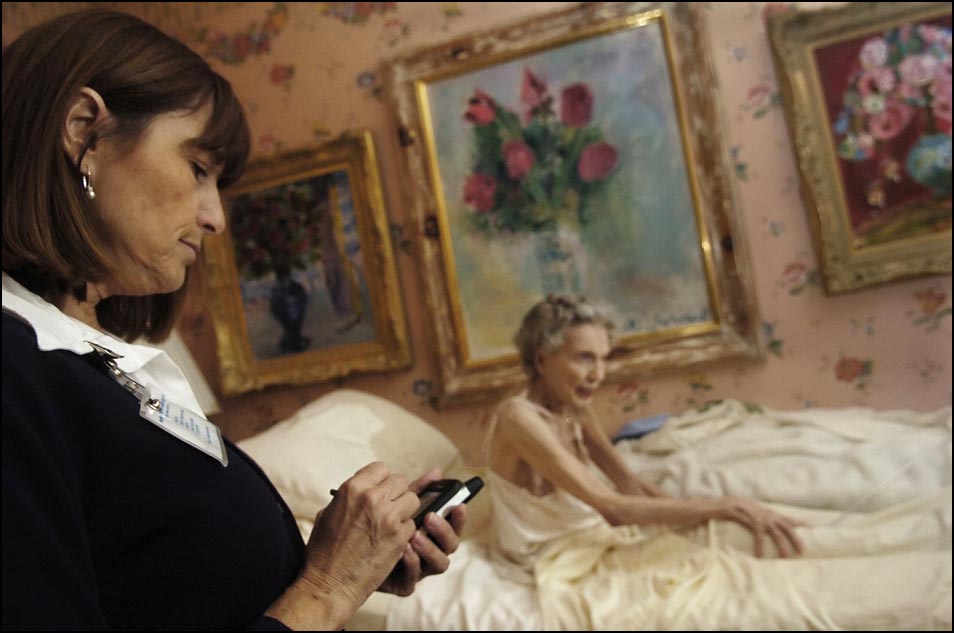
And even if all of that foundation is in place, they may always change their mind or become uncomfortable. That's their right. It's their life and their story, but if you've built a relationship then you can appeal your case more effectively. This happened to me during another story. I got shut out at a critical time while photographing a woman who was pregnant and going through treatment for breast cancer simultaneously. She decided to go through with the pregnancy, despite the advice of some doctors. I was with the couple when she went into labor and was planning to photograph the birth when the mother changed her mind about me being in the delivery room with them. I was disappointed, but that's her right, however I remained at the hospital. Less than an hour after the birth, she began to feed her new daughter with her one remaining breast. I was outside the room, but able to convey the significance of the situation to her husband, who talked to her and then she let me in. I had a really good relationship with the husband and throughout the story, he and I talked about certain things that I photographed. I would like to think that those past discussions led to him having a better understanding of why it was important for me to be there after their daughter was delivered, since I couldn't be there during the delivery.
In addition, it's about building a rapport and trust. I try to be open about my personal life because this exchange is not a one-way street. I can't expect them to open up to me if I'm not willing or able to open up to them. Finding ways to connect helps build those trusting relationships that lead to more honest photos. Sometimes it comes easily and sometimes it can be difficult.
TID:
What did you learn about yourself in the making of this image?
ALEX:
This picture was taken around a time when my approach to photojournalism was changing. I was starting to be influenced more and more by a lot of really inspiring work from photojournalists and photographers whose images felt very personal and communicated in a style that I wasn't accustomed to. For example, I was looking at pictures of people staring straight into the camera, and loving them (and I'm talking more about candid situations, not arranged portraits). To me, those photos were an acknowledgment that the photographer was present which also can elicit a more engaged type of reaction from the viewer. This was a complete 180-degree turn from what I was used to and what struck me was that those types of photos can be just as significant and intense as really intimate photos in which you feel no presence of the photographer.
In my own work, I began looking for people looking at me. If I caught it and the glance resulted in a storytelling photo, then that was great and I liked the idea of expressing the feeling of a situation that way. That made me want to seek out more photos that communicate in a way that I wasn't used to. As a result, I began to rethink what it means to be an invisible, objective observer and consider how I could merge my already-developed way of shooting with what I was now learning.
The other thing that I began to recognize is that WHAT someone chooses to photograph is just as personal as HOW they photograph it.
Part of the great enjoyment about working for a newspaper, or any publication, is being given the trust to interpret a situation however you like so long as that it appropriately tells the story. I've worked for Scripps Treasure Coast Newspapers - along the south/central east coast of Florida - for nearly 10 years. I am very appreciative that we have an editor who has gone to great lengths to instill in the newsroom the philosophy that we should be shooting candidly and unobtrusively, in honest situations. But while shooting for a publication, there is almost always going to be some other influence at work that pulls your lens one direction or another. You're not being told how to look at something, but often you're being told what to look at. Suddenly, I was getting excited by the work that I was seeing that went completely the opposite direction - not influenced by anyone or anything but the photographer and his or her own vision.
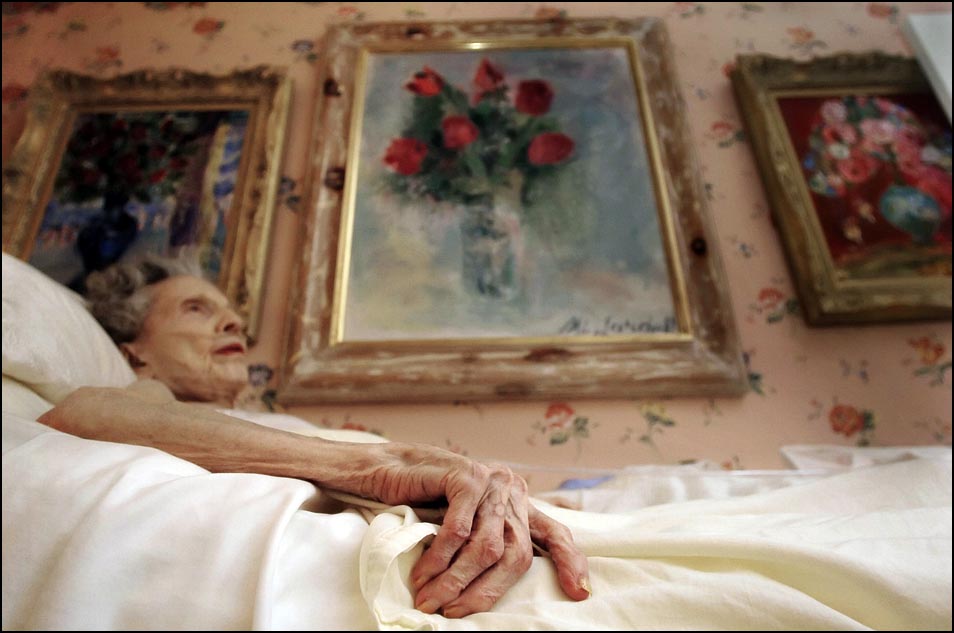
The way I learned to then satisfy both the needs of the paper and my own aspirations to make more personal photos was to either generate more of my own story ideas (which I'm always working to get better at doing) or while at an assignment, make sure I had what I needed for the newspaper, then try to shoot something that was interesting to me, whether it was related to the story or not. This was the case with the photo of Marian sitting forward. It was an outtake from an assignment for a story that was about something else. So within this one assignment, I was able to make two different types of photos - one that ran in the newspaper and told the literal story about the VNA and the other which caught a moment in the life of a 101-year-old woman that hopefully captured her spirit. The process reflected a change and balance that was developing in my photography and that was seeping into my life as well.
So now, I look beyond the story and every assignment becomes an opportunity to photograph everything. Sometimes my editor likes a photo that I shot solely for myself and it makes it into the paper and that's great!
Shoot for yourself. I'd heard it throughout my experience in photojournalism, but now it was really starting to sink in. I wish it hadn't taken me so long to get to that point mentally, but I'm happy to be there now and to be continuously learning and inspired. In the end, I hope that the change in perspective has made me a stronger photojournalist and a more observant person.
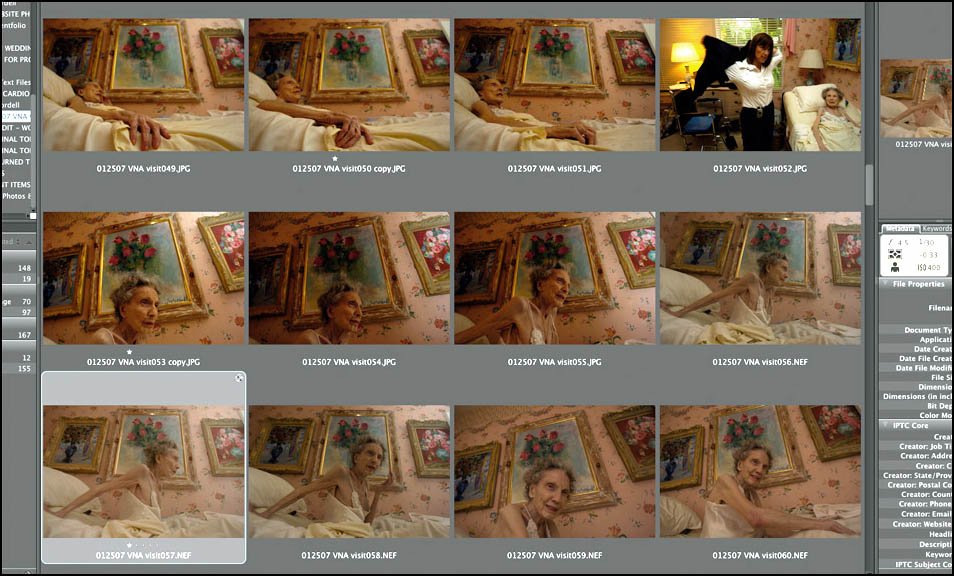
TID:
In conclusion, what advice do you have for photographers in gaining access to these moments?
ALEX:
This moment didn't take much work on my part. I got into a position to make the photo and then got kind of lucky.
But to get to certain moments, sometimes you need an entry point. That entry point can be a person or an organization that knows more than you do about whatever it is you're trying to photograph. (Even in the case with Marian - the moment came somewhat comfortably, but it would not have happened without the Visiting Nurses Association as the guide into her house). If an organization is willing to work with you, they can put you in touch with people who might be willing to be a part of a story.
From there, things begin to grow organically. One person leads to another, leads to another, etc. Once the process starts, then it all goes back to establishing an honest relationship and getting comfortable. Some people are comfortable right off the bat and that's great. But if that's not the case, then I believe simply spending time with them helps. I remember a few times when people were initially hesitant to be photographed, I gave them their space, and then shortly after they seeing me photographing everyone else around them, they decided that they were okay with it. In other words, if you're willing to let things go, they sometimes come right to you.
You don't always have to be shooting when you're with people either. Just go hang out if it feels right and try to learn as much as you can. Any situation can contain significant or intimate moments that speak to grand themes and transcend the scenes and stories. If you've built a comfortable relationship and come across a situation like that you'll know where the boundaries are. And if you're not sure if it's all right to photograph, then just ask.

TID:
In conclusion, how has making these kinds of intimate images changed you as a person?
ALEX:
Seeing up close how people handle their own lives is a huge privilege and I think it has opened my eyes wider to the idea that life is a balancing act of things that you can and cannot control. We can map out our paths to a certain extent, but ultimately, the lives that we construct for ourselves are fragile and can change pretty quickly and severely as a result of unforeseen circumstances.
By recognizing that, it's translated to me personally by being more appreciative of what's good in my life, trying to take the knocks in stride and working to be as prepared as possible for the unknown.
BIO:
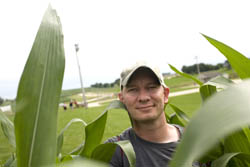
***
Next week we'll explore this powerful image by Alan Spearman:

As always, if you want to interview someone or if you have a suggestion for someone to be interviewed, please contact Ross Taylor at [email protected]